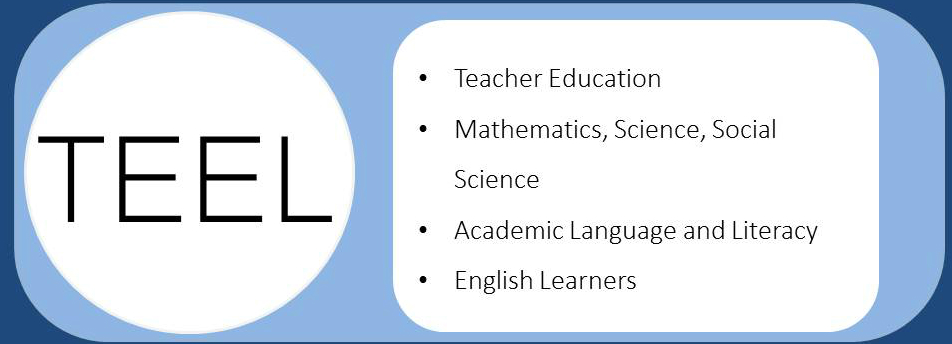The curriculum in the treatment science methods course integrated the ESTELL pedagogy in both content and delivery. The course included readings about and activities exemplifying each of the Five Standards for Effective Pedagogy, as outlined, validated, and tested by CREDE (Doherty, Hilberg, Epaloose & Tharp, 2002). Delivery of the ESTELL pedagogy included meta-pedagogical discussions of the practices. The discussions were defined by moments when the science instructors stepped out of the role of elementary grade teacher, and into the role of teacher educator to underscore a practice, detailing the theoretical origins, research support and how each practice made science more accessible to children learning English as a second language.
Six practices were exemplified in the science methods course. Below an explanation of each is presented.
Practice I. Collaborative Inquiry (CI) is defined by the teacher facilitating learning through purposeful and authentic interaction (e.g., teacher-student; student-student sharing data to exemplify the nature of science—scientists work together. The teacher promotes shared authority with students in the service of solving authentic problems about the natural world around us. Pre-service teachers in the course worked collaboratively to co-construct a science investigation that they presented to classmates and that pulled from their own expertise in relation to the science topic. Discussions of differing cultural knowledge (e.g., medicinal plant use, meaning of weather patterns) in collaboration were discussed and scaffolds to assure full participation by all students were offered (e.g., creating varied grouping structures).
Practice II. Science Talk refers to the opportunities that the teacher structures during a science lesson where he/she can directly model academic discourse patterns through dialogue. Teachers engage students in dialogue by initiating discussions, probing student ideas, and re-voicing student contributions. The re-voicing ensures student responses do not carry tag-questions (e.g., isopods, isn’t it?, erosion?), responses formulated in question format that positions response as unsure and requiring confirmation, common among students from culturally and linguistically diverse backgrounds. The methods instructor provided transcripts of common teacher interactions (Initiation-Response-Evaluate, Mehan, 1979) and proposed other productive interaction patterns (e.g., Think-Pair-Share, Science Discourse Circle).
Practices III & IV. Literacy in Science (LIT) and Language Scaffolding (LS) support science learning by making evident that language and literacy are important tools used by scientists to both talk and write about their findings, as well as sharing those results with others. The methods course used science reference books and science discourse circles as examples of how the language of science can be integrated into instructional plans. For example, teacher candidates kept a Moon Diary where drawings and labels were made to better understand the phases of the moon. Making evident that understanding such a phenomenon is best made accessible with the support of writing was a goal of the session.
Practice V. Contextualized teaching addresses the need to acknowledge students’ prior out of and in school learnings and bridging these to lesson objectives. For example, in the science methods classroom, the instructors promoted probing student experiences with plant life at home and in their communities.
Practice VI. Science Reasoning (SR) refers to teacher moves that promote complex understanding of key concepts by monitoring student understanding, providing purposeful feedback, asking substantive questions, and giving assistance when necessary. The methods instructors displayed these through discussions of the structures and reasons for using particular ways of presenting information. Scaffolds were included that modeled science reasoning, constructing explanations and opportunities for students to reflect on what they learned.
Vocabulary: English Spanish English Spanish Astronomy Astronomia Revolution Revolucion Moon Luna Earth Tierra
Waning Moon Luna Menguante Solar Eclipse Eclipse Solar
Waxing Moon Luna Creciente Spin Giro
Northern Hemisphere Hemisferio Norte Equator Ecuador
Rotation Rotacion Lunar Eclipse Eclipse Lunar
Sun Sol Model Modelo
Seasons Estaciones Tilt Inclinacion
Axis Eje Moon Phases Faces de la Luna
Southern Hemisphere Hemisferio Sur Sunrise El amanecer
Day Dia Night Noche
CA Frameworks/Standards: Earth Sciences, Grade 3
Objects in the sky move in regular and predictable patterns. As a basis for understanding this concept: a) Students know the patterns of stars stay the same, although they appear to move across the sky nightly, and different stars can be seen in different seasons; b) Students know the way in which the Moon’s appearance changes during the four-week lunar cycle; d) Students know that Earth is one of several planets that orbit the Sun and that the Moon orbits Earth; e) Students know the position of the Sun in the sky changes during the course of the day and from season to season.
CA English Language Development Standards Grade 3 Intermediate ELD level focus:
Listening and Speaking
Strategies and Applications: Listen attentively to stories and information and identify important details and concepts• Participate in social conversations with peers and adults on
familiar topics by asking and answering questions and soliciting information.
